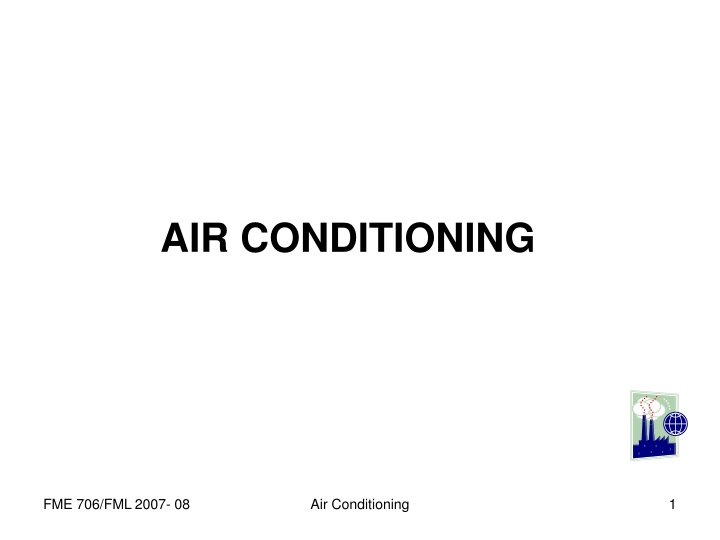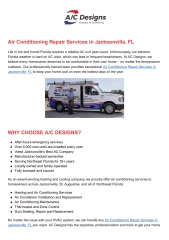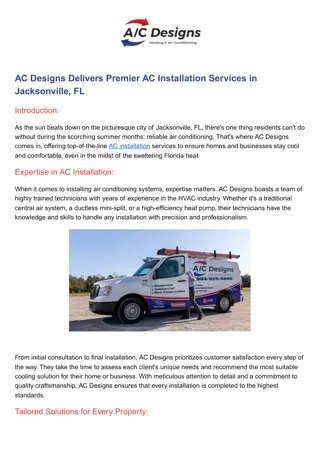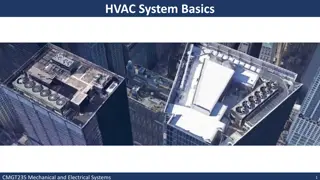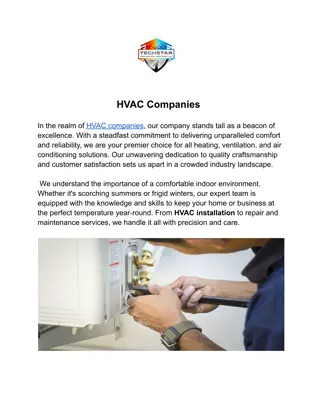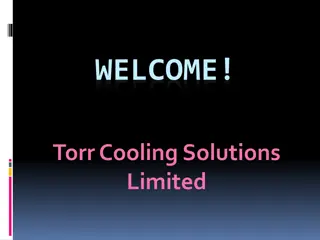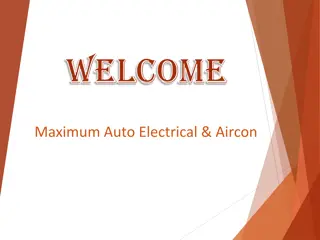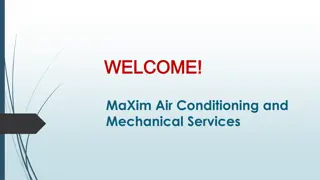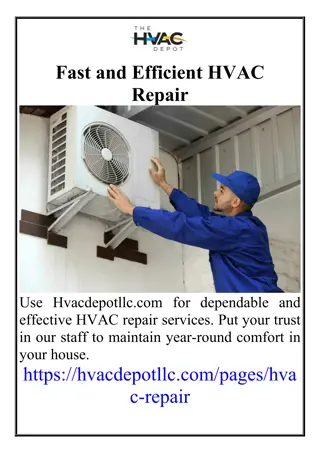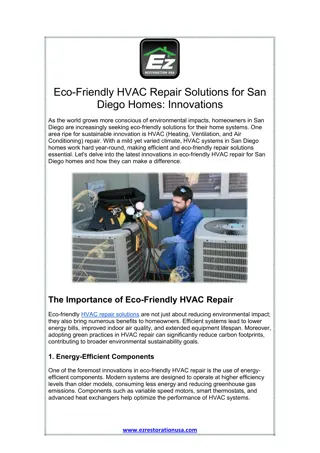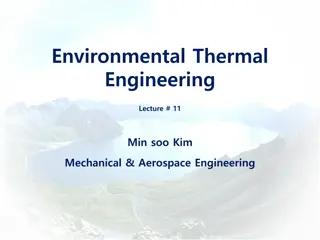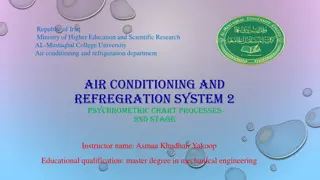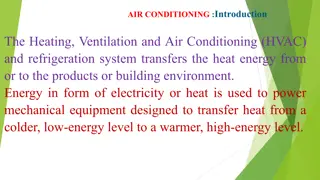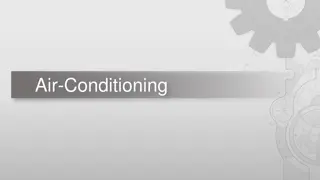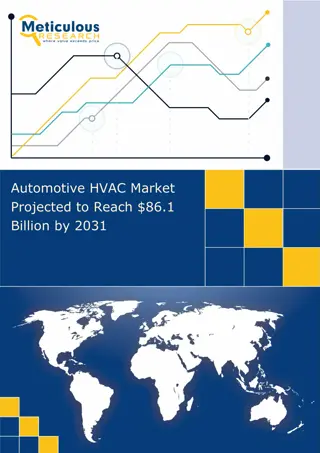Air Conditioning and Psychrometrics in HVAC Systems
Air conditioning systems in HVAC aim to control temperature, humidity, air movement, and air quality for comfort and process control. Psychrometrics studies air-water vapor mixtures, with key parameters like dry bulb temperature and relative humidity. Important psychrometric processes involve adiabatic saturators and thermodynamic systems.
Download Presentation

Please find below an Image/Link to download the presentation.
The content on the website is provided AS IS for your information and personal use only. It may not be sold, licensed, or shared on other websites without obtaining consent from the author.If you encounter any issues during the download, it is possible that the publisher has removed the file from their server.
You are allowed to download the files provided on this website for personal or commercial use, subject to the condition that they are used lawfully. All files are the property of their respective owners.
The content on the website is provided AS IS for your information and personal use only. It may not be sold, licensed, or shared on other websites without obtaining consent from the author.
E N D
Presentation Transcript
AIR CONDITIONING FME 706/FML 2007- 08 Air Conditioning 1
SCOPE AND USE OF AIR CONDITIONING Not restricted to cooling only but might include: o Control of temperature at all times by heating or cooling o Control of air humidity by humidification or dehumidification o Control of air movement at a desirable velocity o Introduction of outdoor air as required o Control of air quality by removal of dirt particles and odorous gases o Control of sound generated by the air conditioning equipment Environmental control Used for two purposes: o Comfort (people) o Process control (as required) FME 706/FML 2007- 08 Air Conditioning 2
PSYCHROMETRICS Study of air-water vapour (binary) mixtures Content of water vapour can change A/C processes may involve both sensible and latent heat transfer SOME IMPORTANT PARAMETERS IN PSYCHROMETRICS Dry Bulb Temperature (TDB) sensed with a normal thermometer bulb/sensor Wet Bulb Temperature (TWB) sensed by a thermometer whose bulb is wrapped with water soaked wick in rapidly moving air Dew Point Temperature (TDP) Temperature at which water vapour starts to condense at constant pressure Humidity Ratio/Specific Humidity (W) Mass of water vapour divided by the mass of dry air (mv/ma kgv/kga) Relative Humidity ( or rh) Ratio of actual water vapour pressure in the air to the water vapour pressure at saturation at the mixture temperature va - volume of a mixture containing one kg of dry air (m3/kga) h enthalpy contained in a mixture containing 1 kga (kJ/kga) va and hinvolve (1+W) kg of mixture FME 706/FML 2007- 08 Air Conditioning 3
PSYCHROMETRICS (Contd 1) PSYCHROMETRIC CHART FME 706/FML 2007- 08 Air Conditioning 4
SOME IMPORTANT PSYCHROMETRIC PROCESSES Thermodynamic Wet Bulb Temperature (Adiabatic Saturator) Air Water Adiabatic wall mw Make-up water Thermodynamic Saturator FME 706/FML 2007- 08 Air Conditioning 5
SOME IMPORTANT PSYCHROMETRIC PROCESSES(cont d 1) T Pv1 Pv2=Pvs2 Handle f2 T2=Tw Dry bulb thermometer Wet bulb thermometer s Adiabatic Saturator H2O Process Sling Psychrometer FME 706/FML 2007- 08 Air Conditioning 6
SOME IMPORTANT PSYCHROMETRIC PROCESSES(cont d 2) + + = + m h m h m h m h m h a a v v w w a a v v 1 1 1 1 2 2 2 2 = = m m m = m m ( W W ) a a a w a 2 1 1 2 = + W h ( 1 h ) h h W h ( 2 h ) v w a a v w 1 2 1 2 hw = hf2, hv1 = hg1, hv2 - hw = hfg2, + h ( h ) W h a a 2 fg = W 2 1 2 1 h h g f 1 2 . 0 622 P P 2 P s = W 2 2 2 s 2 FME 706/FML 2007- 08 Air Conditioning 7
SOME IMPORTANT PSYCHROMETRIC PROCESSES(cont d 3) IMPORTANT RELATIONSHIPS Specific Humidity m W = ~ P V R T P R M P P P 01534 . 18 = = = = = v v a v a v v v v . 0 622 9645 . 28 m R T P V P R M P P P a v a v v a a a a Enthalpy H = = + mi m h m h a m a v v m v = + i h h + = + = i 1 ( ) W h Wh h a v m m a v a a or t c h a + = + = + + = + ( W ) ( ) h c t c Wc t Wh c t Wh p go p p p go p go v a v FME 706/FML 2007- 08 Air Conditioning 8
SOME IMPORTANT PSYCHROMETRIC PROCESSES(cont d 4) Datum: Dry saturated vapour at 0 C, t in C For A/C purposes, cpa 1.005, cpv 1.87 kJ/(kg.K), W 0.01 kgv/kga, hgo = 2500.8 kJ/kg, cp 1.024 kJ/(kga.K), and hence h 1.024t + 2500.8W kJ/kga and W ; ; P = Pa + Pv ; and hence P s a P ( 0.622 0.622 s P P P v = v W = . 0 622 ) ( ) WP W P P P W P P = = = a v s 0.622 P s s Solution for W1 From Adiabatic Saturator + ( ) c t t W h 2 1 2 p fg = W 2 a 1 h h g f 1 2 FME 706/FML 2007- 08 Air Conditioning 9
SOME IMPORTANT PSYCHROMETRIC PROCESSES(cont d 5) Cpa, t1, t2, hfg2, hg1, and hf2 from tables Since at 2 air is saturated, 2 = 1 get W2 from where Ps2 from tables at t2 . 0 622 P 2 P s = 2 W 2 P 2 s 2 Heating and Cooling at Constant W (Sensible) Q W (b) (a) FME 706/FML 2007- 08 Air Conditioning 10
SOME IMPORTANT PSYCHROMETRIC PROCESSES(cont d 6) Q = = + = + = ( ) [( ) ( )] ( )( ) ( ) m h h m h h W h h m c Wc t t m c t t 2 1 2 1 2 1 a a a a v v a p p a p 2 1 2 1 a v Cooling and Dehumidification Q A m w (a) (b) = = + m m m m m ( W W ) or v w v w a 1 2 1 2 Q Q = = + + m h ( a h ) m h ( W W ) m h m h m h or 1 2 a w 1 2 a 1 a 2 w w FME 706/FML 2007- 08 Air Conditioning 11
SOME IMPORTANT PSYCHROMETRIC PROCESSES(cont d 7) ( - ) W W m h a represents enthalpy carried away by the condensate ( 10 C) which is negligible compared to the first term and hence + = w 1 2 Q Q Q s l = Q Q Q Q = = m ( W W h ) 2 s A 2 where and ) 2 l 1 A a 1 fg 1 = = m c t ( p t ) m h ( a h a 1 2 A = m h ( h ) a 1 A Sensible Heat Factor (SHF) (Related to bypass factor) Q s = SHF Q Important in A/C calculations. FME 706/FML 2007- 08 Air Conditioning 12
SOME IMPORTANT PSYCHROMETRIC PROCESSES(cont d 8) Heating With Humidification Q m w (a) (b) = m m ( W W ) w a 2 1 Q h h 2 1 = + h Q = + m h ( h ) m ( W W h ) w or W W m ( W W ) a 2 1 a 2 1 w 2 1 a 2 1 Equation of a straight line. h h 2 1 = h For Q = 0, w W W 2 1 FME 706/FML 2007- 08 Air Conditioning 13
SOME IMPORTANT PSYCHROMETRIC PROCESSES(cont d 9) hw = hgT1 humidification at constant T1(2 ) hw > hgT1 heating with humidification (2 ) hw < hgT1 - cooling with humidification (2) Spray with liquid water at air wet bulb temperature Twb remains constant. Basis of evaporative cooling 2 2 2 1 FME 706/FML 2007- 08 Air Conditioning 14
SOME IMPORTANT PSYCHROMETRIC PROCESSES(cont d 10) Adiabatic Mixing h2 h3 W2 h1 W3 W1 (b) (a) + = + = + = m W m W ; a W m 3 m h m h ; a h m 3 m m m a 1 a 2 3 a a a a 1 a 2 3 1 2 1 2 3 1 2 m m m h h W W h h W W h h W W a a a 3 1 3 1 3 2 3 2 3 2 3 2 = = = = = = 2 1 1 m h h W W m h h W W m h h W W a 2 1 2 1 a 1 3 1 3 a 1 2 1 2 3 2 3 Equation of a straight line (final state lies along this line) FME 706/FML 2007- 08 Air Conditioning 15
SOME IMPORTANT PSYCHROMETRIC PROCESSES(cont d 11) EXAMPLE OF A SIMPLE CENTRAL AIR-CONDITIONING SYSTEM 0 Exhaust Outdoor air Filters Fan 2 1 Cooling & dehumid Coil Space Q=Qs+Ql 5,6,7 3 4 Heater FME 706/FML 2007- 08 Air Conditioning 16
SOME IMPORTANT PSYCHROMETRIC PROCESSES(cont d 1) T4, Q, mao, 5, 6, 7, SHFroom and Qfan known. Draw line from 5, 6, 7 to cross T4 (T5 T4 10 C) Q ma = h h 4 5 4 m W W a = 0 1 Join 0 and 5 locate 1 adiabatic mixing, i.e. 6 W W m 0 6 a 1 Q fan = + h h Hence 2 1 m a 1 For known SHFcoil draw line 2-3, and hence 3-4 at constant W Qcoil = ma1(h2 h3), Qheater = ma3 (h4 h3) FME 706/FML 2007- 08 Air Conditioning 17
COMFORT AND HEALTH Deep body temperature 36.9 C If body can easily maintain an energy balance, then feeling of comfort results Body regulatory mechanisms: Metabolism rate Increase of the rate of cutaneous blood circulation (capillary dilation) Sweating Metabolism depends on the level of activity 1 MET (metabolic rate) = 58.2 W/m2 Energy generated by an average sedentary MAN Area (man) 1.8 m2 1 MET 105 W Women 30% lower than men Latent and sensible Comfort Conditions Depends on activity and clothing 1 clo 0.155 m2.K/W heavy two piece suit with accessories 0.05 clo pair of shorts FME 706/FML 2007- 08 Air Conditioning 18
COMFORT AND HEALTH (contd 1) Examples of Cooling Load Due to Occupancy Activity Example Male Adult Total Watts Total Adjusted Watts Sensible Watts Latent Watts Seated at rest Theatre, movie 115 100 60 40 Seated, very light work, writing Offices, hotels, apartments 140 120 65 55 Standing, light work or walking slowly Retail store, bank 235 185 90 95 Light Bench work Factory 255 230 100 130 Heavy work, heavy machine work, lifting Factory 470 470 165 300 Heavy work, athletics Gymnasium 585 525 185 340 FME 706/FML 2007- 08 Air Conditioning 19
COMFORT AND HEALTH(Contd 2) ASHRAE Comfort Standard 55-81 (1981) (Sedentary) W gv/kga 15 10 Winter Summer 5 20 25 30 C FME 706/FML 2007- 08 Air Conditioning 20
COMFORT AND HEALTH(Contd 3) Cooling T 24 C Heating T 22 C Humidity 40 50 % Velocity in occupied zone V 0.15 m/s For high activity special charts (Fanger comfort Charts ASHRAE HF) FME 706/FML 2007- 08 Air Conditioning 21
COMFORT AND HEALTH(Contd 4) OUTDOOR DESIGN CONDITIONS Winter Summer Design Dry Bulb C Design Wet Bulb C Mean Annual Extrem es 99% C 97.5% C Outdoor Daily Range C Station (Elevation) 1% 2.5% 5% 1% 2.5% 5% Nairobi (1820 m) 7 9 10 27 27 26 13 19 18 18 Addis (2363 m) 2 4 5 29 28 27 16 19 18 18 Lagos (3 m) 19 21 22 33 33 32 7 28 28 29 Dar es Salaam (14 m) 17 18 18 32 32 31 7 28 27 27 FME 706/FML 2007- 08 Air Conditioning 22
COMFORT AND HEALTH(Contd 5) Mean of annual extremes: 99%: Temp. which has been equaled or exceeded 99% of the time during the three cold months (Ditto for 97.5%) 1%: Temp. equaled or exceeded or equaled 1% of the time during the time during the cooling months Daily range: Difference between average maximum and minimum temp. for the warmest month has an effect on the energy storage of structures. Average of the lowest temp. recorded each year over 25-30 years Ventilation Mainly to control odour recommended standards for different spaces (minimum 2.5 l/s) Filtration, washing, scrubbing, adsorption, odour masking and counteraction The smaller the particle, the more difficult to remove Fibrous media (viscous impingement and straining), electronic air cleaners FME 706/FML 2007- 08 Air Conditioning 23
COMFORT AND HEALTH(Contd 6) Cooling T 24 C Heating T 22 C Humidity 40 50 % Velocity in occupied zone V 0.15 m/s For high activity special charts Ventilation Mainly to control odour recommended standards for different spaces (minimum 2.5 l/s) Filtration, washing, scrubbing, adsorption, odour masking and counteraction The smaller the particle, the more difficult to remove Fibrous media (viscous impingement and straining), electronic air cleaners FME 706/FML 2007- 08 Air Conditioning 24
HEAT TRANSMISSION IN BUILDINGS AND COOLING LOAD Cooling Load Temp. and humidity to be maintained at a comfortable level Heat must be extracted cooling load Basis of equipment selection (cooling and dehumidification coil, heater, ducts, fans, piping, fans, pumps, etc.) Convection (delayed in time) Heat storage in furnishings and structure Radiation Heat Gain Cooling load Convection, infiltration FME 706/FML 2007- 08 Air Conditioning 25
HEAT TRANSMISSION IN BUILDINGS AND COOLING LOAD (Cont d 1) Heat gain: radiation, lighting, conduction, convection, people, equipment, infiltration, etc.) Storage effect: Heat does not immediately go into heating the room air. Radiant component first absorbed by room materials before being absorbed by room air. Cooling load: Rate at which heat must be removed to maintain room design conditions (temperature and humidity) Heat being stored Rate at which heat is being received in the space at any time (solar Instantaneous heat gain Removal of stored heat Cooling load Heat Gain and Cooling Load Removal of stored heat Morning Afternoon Evening FME 706/FML 2007- 08 Air Conditioning 26
HEAT TRANSMISSION IN BUILDINGS AND COOLING LOAD (Cont d 2) Heat Gain/Cooling Load Components Conduction through exterior walls, roof and fenestration (glazing/any light transmitting element) Conduction through interior partitions, ceiling and floor Solar radiation (short wave) through fenestration Lighting and equipment Occupancy Infiltration (Fans, duct heat gain, duct leakage) FME 706/FML 2007- 08 Air Conditioning 27
ROOM AIR DISTRIBUTION Good air distribution is necessary for comfort Effective draft temp. difference from design condition between -1.7 C and 1.1 C within occupied zone (approx. < 1.75 m) Air velocities 0.13 0.25 m/s (below or above cause discomfort) AIR FLOW PATTERNS The Horizontal Isothermal Jet FME 706/FML 2007- 08 Air Conditioning 28
ROOM AIR DISTRIBUTION(contd) CL V x I V II III IV o x o A FME 706/FML 2007- 08 Air Conditioning 29
ROOM AIR DISTRIBUTION(contd 1) Zone I Constant centerline velocity Zone II Transition zone Zone III Most important and the longest fully developed flow) - Zone IV Fast velocity decay regarded as still air very short A V o x= K V x o Throw Distance to a specified velocity, e.g. 0.25 m/s Important Characteristics Surface effects increase the throw and decrease the drop (c.f. free jet) Jet parallel to a wall or ceiling tends to hug the surface (reduced entrainment ceiling effect Obstructions e.g. beams, columns etc. Cold jet drop Warm jet - rise FME 706/FML 2007- 08 Air Conditioning 30
ROOM AIR DISTRIBUTION(contd 2) High sidewall diffuser good for cooling Cooling Heating FME 706/FML 2007- 08 Air Conditioning 31
ROOM AIR DISTRIBUTION(contd 3) Ceiling Diffuser Excellent for cooling Large diffusion surface area Handles large quantities of air Beam FME 706/FML 2007- 08 Air Conditioning 32
ROOM AIR DISTRIBUTION(contd 4) Slot Diffusers Long strip-shaped with one or more narrow openings Plenum Ceilings Hung ceilings with slots or perforations for air supply (specialized suppliers/installation) SELECTION CRITERIA FOR DIFFUSERS Capacity Volumetric flow rate Throw Axial distance (isothermal) jet travels till the maximum velocity is reduced to a specified level, e.g. 0.75, 0.5, 0.25 m/s Noise Criterion (NC) Tabulated Standards for different spaces, ducts, applications, fittings Pressure - Ps and Pv or Po FME 706/FML 2007- 08 Air Conditioning 33
ROOM AIR DISTRIBUTION(contd 5) Room Characteristic Length (L) L L High Sidewall Diffuser Ceiling Diffuser FME 706/FML 2007- 08 Air Conditioning 34
ROOM AIR DISTRIBUTION(contd 6) Air Diffusion Performance Index (ADPI) Effective Draft Temperature (EDT) = (tx tc) a(vx b) tx - local temp., C Tc room average temp., C vx local velocity, m/s a = 8, b = 0.15 ComfortConditions:- 1.7 1.1 C; vx < 0.35 m/s ADPI percentage of locations in occupied space of room which meet this criterion FME 706/FML 2007- 08 Air Conditioning 35
ROOM AIR DISTRIBUTION(contd 7) Example Terminal Device Room Load (W/m2) T0.25/L for max ADPI Max ADPI For ADPI greater than Range of T0.25/L 0.7 1.3 Circular 250 1.8 76 70 Ceiling 190 1.8 83 80 0.7 1.2 Diffuser 120 1.6 88 80 0.5 -1.5 65 1.5 93 90 0.7 1.3 FME 706/FML 2007- 08 Air Conditioning 36
BUILDINGS AIR DISTRIBUTION FAN Supply the required air to all conditioned space Must provide the required pressure drop to cater for ducts, diffusers, filters, etc. Types: Axial : a) Vane axial - centerline of duct - guide vanes before and after wheel (rotor) to control rotation of stream - high speed (noisy) b) Tube axial - no guide vanes c) Propeller - low pressure applications - high mass flow rates Centrifugal: a) Forward curved (blades) b) Radial c) Backward curved (airfoil) Most used in A/C can move large or small quantities of air over wide ranges of pressure FME 706/FML 2007- 08 Air Conditioning 37
BUILDINGS AIR DISTRIBUTION (Cont d 1) Fan Selection Fan characteristics Capacity and total pressure Efficiency Reliability Size Weight Speed Noise Cost Duct Design Layout (supply and return) related to supply diffusers and return grilles, location of machine room, and other structural and architectural considerations. Selection of size is a compromise between capital and running costs. FME 706/FML 2007- 08 Air Conditioning 38
HVAC SYSTEMS, EQUIPMENT & CONTROL HVAC systems may conveniently be divided into two broad categories: Equipment and systems which provide heating and cooling Systems which provide ventilation (air distribution and diffusion) It is important to understand the (initial) design of the installation, modifications, operation/performance, utilization hours of operation and even maintenance record (for energy management purposes) HVAC SYSTEMS Related to system organization Energy consumed depends on source of heating/cooling, air distribution, and whether working fluid is simultaneously cooled or heated. ALL AIR SYSTEMS Most common Moderate room air by providing conditioned air from a central source via ducts Control by altering the amount of air supplied or its temperature Provide best control of fresh outdoor air (quality) and humidity control FME 706/FML 2007- 08 Air Conditioning 39
HVAC SYSTEMS, EQUIPMENT & CONTROL(cont d 1) Can be used to provide outside air for cooling interior spaces while providing heating for perimeter zones Drawback energy consumed in distribution Components of All Air Systems Air Handling Unit (AHU) fan, (heating and cooling) coils, filters, humidifier (Supply and return) ducts circulate conditioned air. Sometimes plenum above suspended ceiling used as part of return path Included in duct system is supplier of outdoor air and another for exhausting some of the return air FME 706/FML 2007- 08 Air Conditioning 40
HVAC SYSTEMS, EQUIPMENT & CONTROL(cont d 2) Single Zone Air Conditioning System Layout Cooling & dehumid coil Preheat coil (opt) Supply fan Supply air Outdoor air Filters Heating or reheat coil (opt) Room(s) Exhaust air Return air Return fan FME 706/FML 2007- 08 Air Conditioning 41
HVAC SYSTEMS, EQUIPMENT & CONTROL(cont d 3) Can be used for all year round control Can use 100% outdoor air during intermediate cooling seasons refrigeration equipment not used Control of proportion of outdoor air Max Outdoor air Mixed supply to AHU Min Return Exhaust FME 706/FML 2007- 08 Air Conditioning 42
HVAC SYSTEMS, EQUIPMENT & CONTROL(cont d 4) Pre-heat coil in cold climates to prevent cooling coils from freezing Face bypass provides another method of controlling humidity but not as good control as reheat coil Bypass damper Cooling and dehumid coil Face damper Single zone systems suitable for large open spaces with uniform load, e.g. stores, factories, arenas, auditoriums, exhibition halls, etc FME 706/FML 2007- 08 Air Conditioning 43
HVAC SYSTEMS, EQUIPMENT & CONTROL(cont d 5) Variable Air Volume (VAV) Systems Same as single zone but individual thermostats control the amount of air supplied to room VAV FME 706/FML 2007- 08 Air Conditioning 44
HVAC SYSTEMS, EQUIPMENT & CONTROL(cont d 6) High degree of local temperature control Moderate additional capital cost AHU pressure increases (additional P for VAV) AHU needs regulation to balance varying duct P requirements (fan inlet and outlet dampers) Fan would operate off the optimum position need variable speed drive Supplementary heating may be necessary (minimum air to space must be supplied) Single duct VAV systems most versatile and most widely used for large buildings (except where high degree of humidity control is required or high air exchange) FME 706/FML 2007- 08 Air Conditioning 45
HVAC SYSTEMS, EQUIPMENT & CONTROL(cont d 7) Reheat Systems Reheat coils Zone 1 m s1 c AHU Zone 2 o Zone 3 Return o m z1 c s1 FME 706/FML 2007- 08 Air Conditioning 46
HVAC SYSTEMS, EQUIPMENT & CONTROL(cont d 8) Provides individual zone control of temp. and humidity Wasteful all air has to be cooled and then heated double use (waste) of energy (cooling and then reheating) Constant Air Volume (CAV) and VAV Reheat systems inefficient highest level for all systems (CAV reheat systems most inefficient. VAV reheat inactive except when air modulation cannot meet minimum temp. requirements) CAV and VAV systems with reheat can provide extremely tight control conditions (with humidity control) e.g. museums, printing plants, textile mills and other industrial process settings) FME 706/FML 2007- 08 Air Conditioning 47
HVAC SYSTEMS, EQUIPMENT & CONTROL(cont d 9) Multizone Systems Cooling Heating FME 706/FML 2007- 08 Air Conditioning 48
HVAC SYSTEMS, EQUIPMENT & CONTROL(cont d 10) A variation of the single duct CAV reheat system (NOT any system with thermostatically controlled zones misconception) Most common systems produce two streams at ~ 38 C and ~ 13 C Streams blended with dampers to adjust room supply air temp. Dual Duct Systems Air not blended in the fan room Usually uses high velocity ducts (reduces size and cost of ducts but increased fan energy) with mixing boxes Limited to buildings with strict temp. and humidity control requirements Dual duct with VAV has efficient control (c.f. CAV) but requires a lot more distribution energy FME 706/FML 2007- 08 Air Conditioning 49
HVAC SYSTEMS, EQUIPMENT & CONTROL(cont d 11) Heating Hot duct Filters Mixing box To zone To zone Cold duct Cooling Return FME 706/FML 2007- 08 Air Conditioning 50
